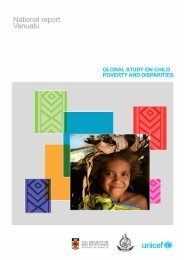A Strategic Assessment of the Children's Services Industry
A Strategic Assessment of the Children's Services Industry
A Strategic Assessment of the Children's Services Industry
- No tags were found...
You also want an ePaper? Increase the reach of your titles
YUMPU automatically turns print PDFs into web optimized ePapers that Google loves.
STRATEGIC ASSESSMENT OF THE CHILDREN’S SERVICES INDUSTRYrapid expansion <strong>of</strong> long day care places since <strong>the</strong> early 1990s. The mixed market is a centralfeature <strong>of</strong> <strong>the</strong> Australian children’s services industry and will remain so for <strong>the</strong> foreseeablefuture. The nature <strong>of</strong> <strong>the</strong> market reinforces <strong>the</strong> importance <strong>of</strong> policies geared to <strong>the</strong>enhancement and monitoring <strong>of</strong> service quality. This, in turn, requires accurate andcontinuous information about standards and quality in all publicly funded settings. This isparticularly so given <strong>the</strong> broad public policy goals being linked to Australia’s early childhoodservices agenda. The existence <strong>of</strong> a mixed market introduces some new issues into strategicthinking. For example, international literature and a small number <strong>of</strong> Australian researchstudies show a trend for <strong>the</strong> highest quality care to be associated with non-pr<strong>of</strong>it andindependent private providers, and <strong>the</strong> poorest quality care with corporate chains. Australia’scommitment to evidence-informed policy requires fur<strong>the</strong>r research to test <strong>the</strong> relevance <strong>of</strong><strong>the</strong>se findings in Australia and to develop strategies to ensure that high quality is beingdelivered in all settings.The international focus on ECEC and <strong>the</strong> policy initiatives and research it has generated,provide a valuable knowledge base for Australian policy makers. New Zealand, <strong>the</strong> UnitedKingdom, Sweden and parts <strong>of</strong> Canada have all embarked on policy agendas that focus on <strong>the</strong>needs <strong>of</strong> children in <strong>the</strong>ir early years, that move beyond separate spheres <strong>of</strong> education andcare and that seek more integrated, holistic service provision. New Zealand began thisprocess earlier than most, uniting education and care services in a single department in 1986.The UK has similarly brought toge<strong>the</strong>r policy responsibility for education and care. Inaddition, <strong>the</strong> UK has built hubs for <strong>the</strong> delivery <strong>of</strong> integrated services; <strong>the</strong>se ‘Children’sCentres’ to be located in every neighbourhood, provide education, care, health and familysupport. The experience <strong>of</strong> all <strong>the</strong>se countries shows that integration involves more thanreorganising policy responsibility or <strong>the</strong> delivery <strong>of</strong> a range <strong>of</strong> services for children from asingle site. Child-focused integration extends beyond <strong>the</strong> policy arenas <strong>of</strong> early education andcare. So in <strong>the</strong> UK, integration has been designed to address poverty alleviation and maternalemployment goals. In Sweden, integration has occurred between preschool (1-6 years) andprimary school curricula, in which each influenced <strong>the</strong> o<strong>the</strong>r.Comprehensive approaches to early childhood service provision require close attention to <strong>the</strong>staff who work in ECEC services, <strong>the</strong>ir qualifications, pay and conditions and careerprospects. New qualifications and career paths have been developed in <strong>the</strong> UK, New Zealandand Sweden specifically for early teachers. New mechanisms have been developed torecognise <strong>the</strong> experience <strong>of</strong> staff already engaged in providing education and care. In NewZealand, pay parity has been achieved between early years teachers and primary schoolteachers. New funding mechanisms were implemented in Quebec so that parents pay $7 for afull day <strong>of</strong> ECEC, in this way overriding <strong>the</strong> education and care split between operationalsubsidies for education and fee subsidies to enable parents to purchase care. The differentneeds <strong>of</strong> parents and children have been addressed, so that in Quebec, parents can, if <strong>the</strong>ywish, place <strong>the</strong>ir children in a single high quality service for up to 10 hours per day whichboth meets <strong>the</strong> needs <strong>of</strong> employed parents and <strong>of</strong> children for quality education and care.Australia is on <strong>the</strong> threshold <strong>of</strong> an exciting era in <strong>the</strong> development <strong>of</strong> early childhoodeducation and care. Collaboration, goodwill and sustained innovation in policy and fundingapproaches are essential to move forward on <strong>the</strong> agenda now in play. The principles andstrategies outlined below will help move Australia closer towards this goal.iv
















